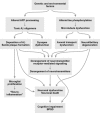Cerebral correlates of psychotic syndromes in neurodegenerative diseases
- PMID: 21418522
- PMCID: PMC4365880
- DOI: 10.1111/j.1582-4934.2011.01311.x
Cerebral correlates of psychotic syndromes in neurodegenerative diseases
Abstract
Psychosis has been recognized as a common feature in neurodegenerative diseases and a core feature of dementia that worsens most clinical courses. It includes hallucinations, delusions including paranoia, aggressive behaviour, apathy and other psychotic phenomena that occur in a wide range of degenerative disorders including Alzheimer's disease, synucleinopathies (Parkinson's disease, dementia with Lewy bodies), Huntington's disease, frontotemporal degenerations, motoneuron and prion diseases. Many of these psychiatric manifestations may be early expressions of cognitive impairment, but often there is a dissociation between psychotic/behavioural symptoms and the rather linear decline in cognitive function, suggesting independent pathophysiological mechanisms. Strictly neuropathological explanations are likely to be insufficient to explain them, and a large group of heterogeneous factors (environmental, neurochemical changes, genetic factors, etc.) may influence their pathogenesis. Clinico-pathological evaluation of behavioural and psychotic symptoms (PS) in the setting of neurodegenerative and dementing disorders presents a significant challenge for modern neurosciences. Recognition and understanding of these manifestations may lead to the development of more effective preventive and therapeutic options that can serve to delay long-term progression of these devastating disorders and improve the patients' quality of life. A better understanding of the pathophysiology and distinctive pathological features underlying the development of PS in neurodegenerative diseases may provide important insights into psychotic processes in general.
© 2011 The Author Journal of Cellular and Molecular Medicine © 2011 Foundation for Cellular and Molecular Medicine/Blackwell Publishing Ltd.
Figures



References
-
- Wikipedia. Dementia. http://enwikipediaorg/wiki/Dementia 2010; accessed January 17, 2011.
-
- Piccininni M, Di Carlo A, Baldereschi M, et al. Behavioral and psychological symptoms in Alzheimer’s disease: frequency and relationship with duration and severity of the disease. Dement Geriatr Cogn Disord. 2005;19:276–81. - PubMed
-
- Braak H, Braak E. Neuropathological stageing of Alzheimer-related changes. Acta Neuropathol. 1991;82:239–59. - PubMed
-
- Lopez OL, Becker JT, Sweet RA, et al. Psychiatric symptoms vary with the severity of dementia in probable Alzheimer’s disease. J Neuropsychiatry Clin Neurosci. 2003;15:346–53. - PubMed
Publication types
MeSH terms
LinkOut - more resources
Full Text Sources
Other Literature Sources
Medical
Molecular Biology Databases

